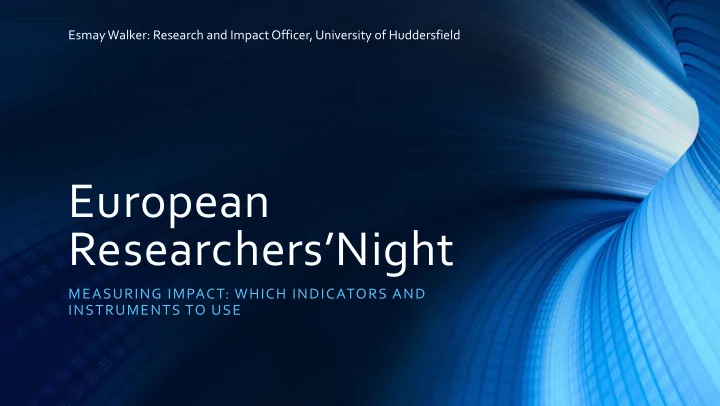

Esmay Walker: Research and Impact Officer, University of Huddersfield European Researchers’Night MEASURING IMPACT: WHICH INDICATORS AND INSTRUMENTS TO USE
Establishing Impact Indicators Why? • Demonstrate real-world value of research • Increased awareness among the general public of the • Positive interactions with • Reduction in stereotypes importance of research researchers about researchers and their profession • Better understanding of the • Engaging and inspiring event key benefits that research • Increase, in the long term, of brings to society people taking up research careers What? How?
What measurements reflect this change? • Online & paper questionnaires on perceptions and attitudes before and after or during the event. • Informal interviews during the event and surveys on specific activities and general event. • Age appropriate surveys- make it easy for people! • Quantitative and Qualitative data combined • Incentivized questionnaires- visitors feel they are receiving potential payback for time taken to complete the survey
Tailored Surveys to Increase Respondents
Impact for free... • Paper surveys- seek inspiration from similar events and devise your own to run on Welcome Points • Online/iPad surveys- make use of free online survey tools such as BOS and Survey Monkey • Media students and local TV companies for individual interviews with visitors- brief them with your questions • School newsletters and websites- link to your survey when sending promotional material • Registration websites (e.g. Eventbrite) help you to stay in touch with your visitors
The Big Three: Making Data Meaningful • Gender - to identify existing attitudes in relation to gender (e.g. do girls feel less inclined to pursue careers in science or technology?) • Age – allows us to analyse if the event is effective in shifting perceptions of all age groups • Perceptions/Attitudes - provides us with rich data as opposed to just bare statistics
5 Golden Rules….. • Don’t ask what you don’t need to know! • Keep it brief and straightforward to increase uptake- ideally no more than 15 questions • Start with quantitative, finish with qualitative and avoid ‘neutral’ options whenever possible • Tailor surveys to different groups and catch people early • Never forget the baseline to change rule when measuring shifts in attitude
What level of change can we expect to see? Survey for children aged 5-18 years 100% 90% 83% 80% 69% 70% 57% 60% 50% 40% 30% 30% 20% 10% 0% Would you consider a career Do you understand what it in science or research? means to be a researcher? Before After
Why collect qualitative data? • Paints an overall picture of attitudes and opinions • Can support the statistical data by making it richer and more relevant • Highlights unintended impacts • Provides useful information that can be applied to future events • Useful for marketing and promotion • Gives visitors a voice
Thanks for your time and stay in touch! e.walker@hud.ac.uk
Recommend
More recommend